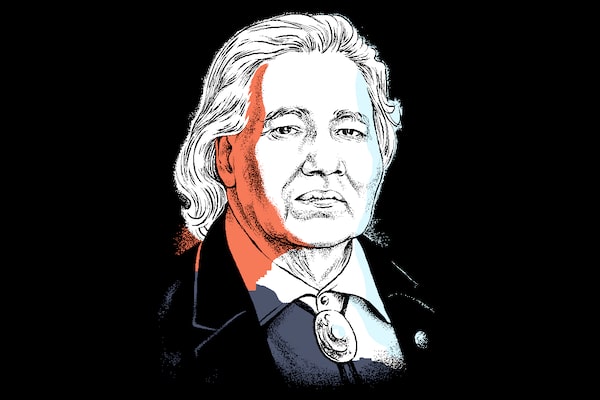
Illustration by Agata Nowicka
The words are so shocking, so evocative of foreign atrocities, that many Canadians are still unwilling to accept that they apply to their own country – words such as “apartheid,” “genocide” and “war.”
But after decades of research from his inquiries into racial abuses in the justice system and in residential schools, Senator Murray Sinclair never hesitates to use those terms – even when he knows they might spark a backlash.
“Sometimes the shock value is worth it,” he told The Globe and Mail.
“It’s about making people sit up and take notice. It’s about getting people out of their comfortable chair and getting them to think seriously about it.”
A strong case can be made that the 68-year-old independent senator and retired judge has done more than any other Canadian to educate the country about the painful realities that have dogged its history and institutions.
As chair of the Truth and Reconciliation Commission of Canada from 2009 to 2015, he documented the existence of cultural genocide in Canada’s residential schools. As a leader of justice and policing investigations in Manitoba and Thunder Bay, he exposed officials who were willfully ignoring racism in their police forces. And in his personal writing and speeches, Mr. Sinclair has hit even harder, describing a web of genocidal policies and apartheid laws that Canadian governments deployed in a “war” against Indigenous people – a war he says never really ended.
Although his formal inquiries have ended, his work is far from over. As he tirelessly follows a busy schedule of speeches across the country this year – including a recent one describing how Indigenous people were excluded from Confederation’s bargains – Mr. Sinclair continues to have an outsized influence in shaping Canada’s understanding of itself.
He sees himself as struggling to dismantle the legacy of a system that can be compared, in many ways, to the apartheid of South African history. Despite frequent hate messages on Twitter and Facebook, he continues to make that point on social media, shrugging off the anonymous attacks.
“There will be people who will always resist those statements,” he said in a two-hour interview in his Winnipeg office, symbolically located on an “urban reserve” under the authority of the Peguis First Nation.
“If you say that there’s been racism by white people against Indigenous people historically, you run the risk of white people standing up and saying, ‘No, we’re not racist.’ But if the evidence is there to support your position, you will also garner a level of support among the non-Indigenous population who will say, ‘Yes, we acknowledge it, so let’s get on with it.’"
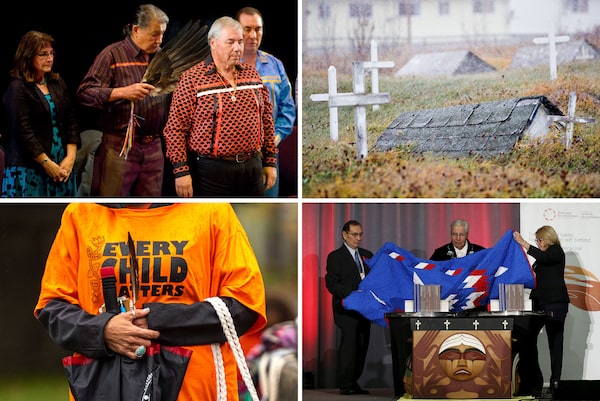
At top left, Mr. Sinclair is ceremonially welcomed as TRC chair in 2009. The commission's task was to learn what happened at the schools, such as Wabasca Residential School, whose unmarked graveyard is shown at top right. In 2015, commissioners unveiled the final report, shown at bottom right. Since then, Canadians have honoured residential-school survivors on annual Orange Shirt Days on Sept. 30, like the one shown at bottom left in Thunder Bay this year.The Globe and Mail, The Canadian Press, Reuters
His inquiries, beginning with the pioneering Aboriginal Justice Inquiry of Manitoba in the late 1980s, were prompted by tragedies and injustices: the deaths of young Indigenous people in Manitoba and Thunder Bay and in residential schools, neglected by the police and the courts and never properly investigated.
But from those tragedies, Mr. Sinclair found lessons that have shifted Canada’s public debates.
When he was appointed associate chief judge of the Provincial Court of Manitoba in 1988, he became the province’s first Indigenous judge and only the second in Canada. Within weeks, he was immersed in a hugely complex inquiry into the discrimination faced by Indigenous people in the province’s justice system. His relentless work to expose the barriers that hold back Indigenous people – and to find solutions – has scarcely paused in the three decades since then.
In interviews, he chooses his words carefully, speaking in calm and measured tones, even when his anger at historical abuses is clear. In speeches, he uses gentle humour and warm stories of his own family to make his points.
His goal is to reach Canadians who are open to learning about the country’s history – to give them “the sense that now they can talk about it, too.
“It’s not simply about confronting, it’s also about assisting. The intent from that is always, ‘So what are you going to do about it? So what should we do about it?’ Statements like ‘there’s racists in society’ that are not accompanied by ‘now what should we do about it?’ are not very helpful.”
Mr. Sinclair walks in Winnipeg in 1998, when he was heading an inquiry on baby deaths. A decade earlier, he was investigating the plight of Indigenous people in the city.The Canadian Press/Winnipeg Free Press/The Canadian Press
Murray Sinclair was born in 1951 near Selkirk, north of Winnipeg. The area was once known as the St. Peter’s Indian Reserve, until 1907, when most of its Ojibwa and Cree people were illegally forced to relocate about 170 kilometres to the northwest, to what is now the Peguis First Nation.
His father and grandmother were survivors of residential schools. His mother died when he was an infant and he was raised by his grandparents.
His Ojibway name is Mizanay Gheezhik – “the one who speaks of pictures in the sky” – an allusion to his role as an educator who helps his people understand their lives.
He was a star athlete and class valedictorian at Selkirk Collegiate, graduating in 1968. He studied for two years at the University of Manitoba, worked for the Selkirk Friendship Centre, served as a leader of the Manitoba Metis Federation and was hired in 1973 as an assistant to Howard Pawley, a future premier of Manitoba, who was then the attorney-general. Three years later, he entered law school, graduating in 1979.
As a lawyer in Winnipeg for the next eight years, he experienced racism at close quarters. In the courtroom, judges sometimes assumed that he was the defendant because he was Indigenous.
“It happened more than once,” he recalled. “I had the suit, I had the tie, I had the briefcase – I even drove the car. But when they called the name of my client and I stood up, the judge said, ‘Well, mister, what are you charged with?’ ”
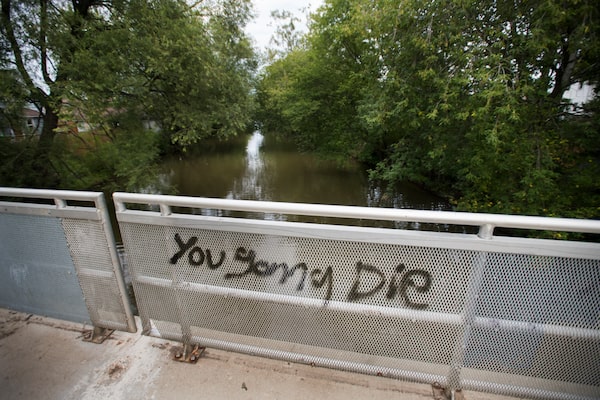
Graffiti is sprayed on a pedestrian bridge over Thunder Bay's Lower Neebing River. In recent years, the deaths of Indigenous teens in the city's waterways has fuelled public anger at the police.Fred Lum/The Globe and Mail
In an investigation into the Thunder Bay Police Services Board, the results of which were published last December, he ruffled feathers by identifying problems with “systemic racism” – a term he also used in Manitoba. “People just didn’t understand the idea of what systemic racism is,” he said.
“When we were talking to officials, particularly at the police board, it was very clear to me that they thought we were accusing every cop of being a racist. But I explained to them that it’s the system itself that is founded upon beliefs and attitudes and policies that virtually force even the non-racist person to behave in a racist way. If you get rid of all the racists in every police force, you’ll still have a systemic racism problem.”
In his 160-page report for the Ontario Civilian Police Commission (OCPC), he found that the police board had a “willful blindness” to racism on the force. “The Board has failed to recognize and address the clear and indisputable pattern of violence and systemic racism against Indigenous people in Thunder Bay,” he wrote.
The report persuaded the OCPC to declare an emergency, disband the police board and appoint a temporary administrator while the board’s new members were given cultural training.
“It sent a message about how intractable the problem was,” said Julian Falconer, a lawyer who has represented Indigenous organizations and families at inquests in Thunder Bay.
“It was huge. It sent shock waves across the province because it was such a severe remedy – it was very rare for that to ever happen.”
Mr. Falconer said he still uses the Sinclair report for training purposes – to show police boards what they must not do. “His report was, frankly, a groundbreaker.”
Gerry McNeilly, author of an independent review of the Thunder Bay police, releases his findings in Thunder Bay last December.David Jackson/David Jackson/The Globe and Mail
Two days before it was published, a report by the Office of Independent Police Review Director had made similar findings, after an inquiry sparked by discontent with the police handling of multiple deaths and disappearances in the Indigenous community. Within hours of that report’s release, the Thunder Bay Police Service issued a statement acknowledging that systemic racism existed in the force.
Since then, Thunder Bay’s police chief has announced a review of the force’s investigations into the deaths of nine Indigenous people, going back more than a decade.
As he investigated the Thunder Bay police board, Mr. Sinclair found striking parallels to the issues he uncovered in Winnipeg in the late 1980s. “Despite the very apparent similarities in the operations of the two police forces, there were no tools or systems in place to counteract the history of bias that influences the way police officers function,” he said.
“They’re still recruiting police officers who have a macho tendency and police officers who are related to other police officers. We were told that 15 to 20 per cent of the Thunder Bay police force are related to each other.”
Mr. Sinclair, shown in 2015 when he was still chair of the TRC, says his biggest passion is education.Dave Chan/The Globe and Mail
But while his inquiries have made hundreds of detailed recommendations to improve Canada’s justice and social systems, Mr. Sinclair’s biggest passion is education. He wants Canadians to know the truth about their own history – and the legacy of that history.
During the Manitoba justice inquiry, he searched for a television network to carry the hearings, eventually finding a new cable company that would broadcast them across the province. “We were putting the relationship between aboriginal people and the justice system at the dinner table of everybody’s house every day,” he said.
“It influenced the thinking of Manitobans and caused them to realize that there was a lot of validity in what was being said, because it was being said by such honest people in such an open and forthright way.”
Under his leadership, the Truth and Reconciliation Commission (TRC) heard testimony from 6,500 witnesses in public hearings over four years, often with large audiences and almost all of them videotaped so that others could see them, too. It was so influential that Mr. Sinclair still receives almost daily notices of its report being cited in court judgments and scholarly articles, including almost 200 cases at the Supreme Court of Canada alone.
He still thinks the National Inquiry into Missing and Murdered Indigenous Women and Girls, held from 2016 to 2019, could have had a greater impact if it had followed his practices in the Manitoba and TRC inquiries. “We pushed the lawyers out of the room, so there were no lawyers running the show,” he said of those hearings.
“I think it was one of the failings of the inquiry into murdered and missing Indigenous women, and why it stumbled so often. I think the lawyers were too influential. Lawyers are trained to do things in a courtroom-type manner.”
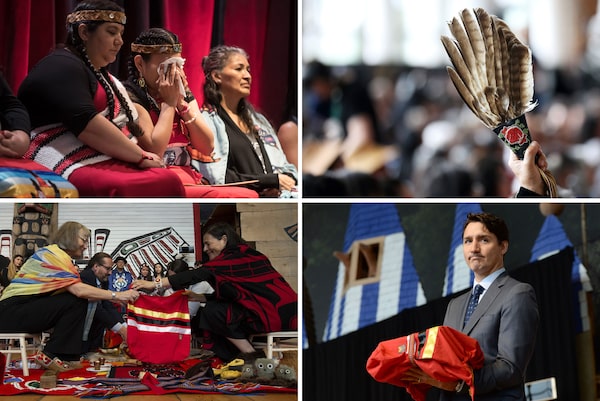
At a ceremony in Gatineau, Que., this past June, survivors and families were on hand as commissioners released their final report on missing and murdered Indigenous women in Canada. Prime Minister Justin Trudeau accepted a signed copy of the report.The Canadian Press, Reuters
At the provincial and territorial level, Mr. Sinclair has supported efforts to overhaul school curriculums to include more Indigenous history, although those efforts have had little success. “Until we can get that knowledge basis in the curriculum, so that people can be educated fully about what the government has done, we will still have that population of deniers,” he said.
He also promotes his education campaign on Twitter and Facebook. “There’s an audience out there that looks to social media for information,” he said. But that has led to a backlash that includes thousands of hate messages on social media and in e-mails. The hate doesn’t bother him. “I’m too thick-skinned. I just block them.”
A truthful education system, he believes, would shatter the myth of a benevolent Canadian government that couldn’t possibly have been involved in genocide or apartheid. Genocide, he argues, doesn’t necessarily mean the outright murder of people. It can be manifested in the forced sterilization of Indigenous women or the removal of children from their families to indoctrinate them in residential schools. It can also take the form of deliberate starvation of Indigenous people on the Prairies to remove them from the path of the railway, as happened under Sir John A. Macdonald.
In speeches, Mr. Sinclair describes how Canadian governments crushed Indigenous culture with laws to destroy traditional leadership, prohibit court challenges, ban protests and even outlaw the wearing of traditional garb. “They used the law as a weapon to take away Indigenous rights,” he said in conversation with another Indigenous senator, Dan Christmas, to mark Indigenous History Month this year. “That war never really stopped, and there are still many people today who are still fighting that war.”
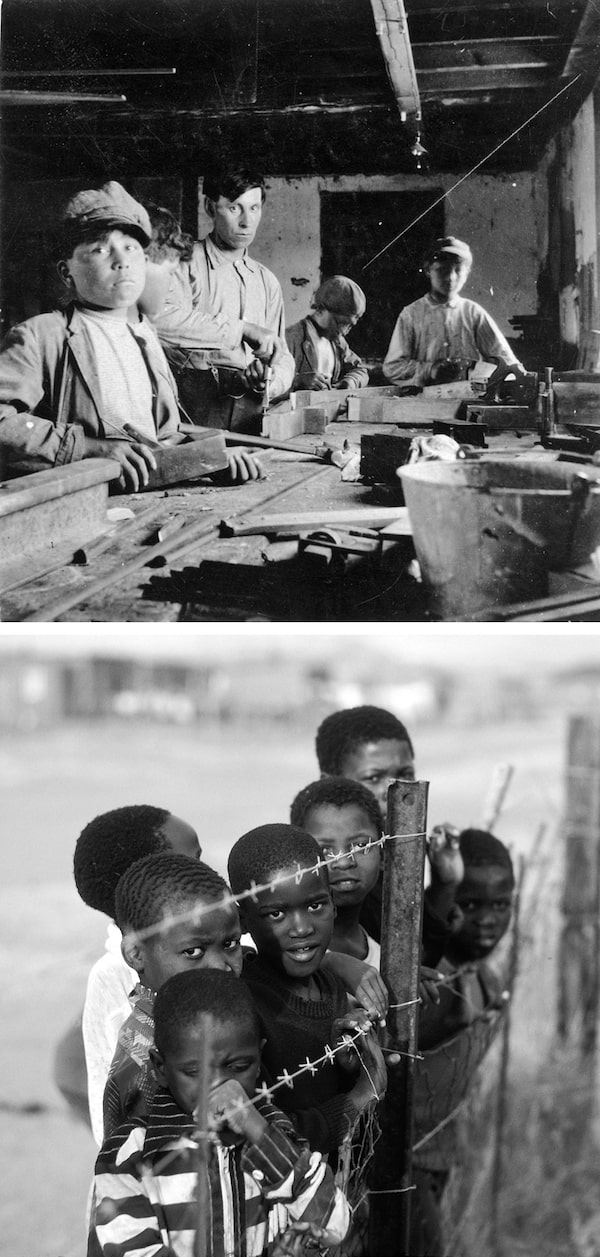
Above, children work in carpentry class at the Brandon Industrial Institute, a residential school in Manitoba, in 1910. Below, children stand behind a fence in Ekuvukene, one of the 'homelands' where black South Africans were forcibly resettled during apartheid in 1982.United Church of Canada archives; United Nations
When then-Justice Minister Jody Wilson-Raybould spoke in 2017 about the parallels between Canada and South Africa, an editorial in The Globe questioned the accuracy of her comments. But a day later, in a Facebook post, Mr. Sinclair cited the historical evidence to support her. “Excuse me, but apartheid is exactly what happened here,” he wrote.
Canada’s apartheid era began after Confederation with laws that allowed a colonizing minority to seize power over an Indigenous majority in Western Canada, he said. “That apartheid system still exists. … We do have a lot to learn from the South African experience. Never trust the colonizer’s history.”
During his inquiry into residential schools, Mr. Sinclair came across scholarly research that revealed how officials from South Africa had visited Canada to study the pass system of special travel permits and other rules that controlled the movement of Indigenous people. A nearly identical system was later adopted in apartheid South Africa. “They came to study how Canada did it – how Canada controlled such a large population of Indigenous people.”
But the system of control in Canada comprised more than just laws. He borrows a psychological term, “gaslighting,” to describe how Indigenous people were persuaded to blame themselves for their own poverty and to feel fortunate to be ruled by a benevolent government that had “saved” them from extinction.
“The perfect crime is not the unsolved crime. The perfect crime is when you convince the victim that he’s at fault and the victim himself stands up and says, ‘I was never the victim of a crime.’ That’s what gaslighting is. Indigenous people for the longest time believed it was something wrong with us, that we were weak, we were poor and it was our poverty that caused our situation.”
When gaslighting loses its power, disenfranchised Indigenous people can embark on a path of frustration and anger that leads ultimately to violent rebellion, Mr. Sinclair warns, citing the theories of anti-colonial political philosopher Frantz Fanon, who had a huge influence on African liberation struggles.
“One of the most impressive Indigenous leaders I ever met was a young man who led a Winnipeg street gang,” Mr. Sinclair said. “He could have been the head of a corporate executive team. He had the ability to think, to plan and to read financial statements, and he only had a Grade 10 education. … When the gang leaders get out of jail, if they’re frustrated and put their mind to organizing young people to start taking action against the white guy, they could become quite a social force.”
For now, the Canadian government is doing just enough to appease the Indigenous community and keep it from taking up arms or organizing a broader protest movement, he said.
“I’m not sure we’re that close yet. But as Fanon says, it won’t take much.”
Our Morning Update and Evening Update newsletters are written by Globe editors, giving you a concise summary of the day’s most important headlines. Sign up today.
 Geoffrey York
Geoffrey York